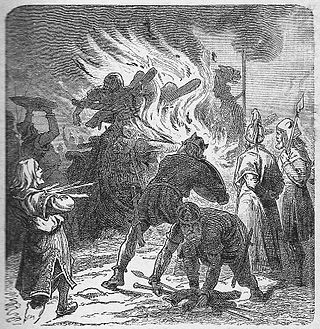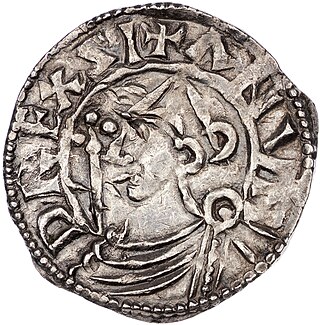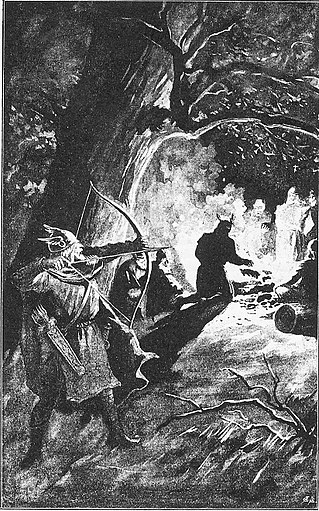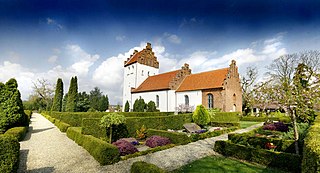Related Research Articles

Harald "Bluetooth" Gormsson was a king of Denmark and Norway.

Ragnar Lodbrok, according to legends, was a Viking hero and a Swedish and Danish king.

Gorm the Old, also called Gorm the Languid, was ruler of Denmark, reigning from c. 936 to his death c. 958 or a few years later. He ruled from Jelling, and made the oldest of the Jelling stones in honour of his wife Thyra. Gorm was born before 900 and died perhaps around 958 or possibly 963 or 964.
Fróði is the name of a number of legendary Danish kings in various texts including Beowulf, Snorri Sturluson's Prose Edda and his Ynglinga saga, Saxo Grammaticus' Gesta Danorum, and the Grottasǫngr. A Danish king by this name also appears as a minor character in the Middle High German epic Rabenschlacht. The name is possibly an eponym for the god Freyr.

Eric the Victorious was a Swedish monarch as of around 970. Although there were earlier Swedish kings, he is the first Swedish king in a consecutive regnal succession, who is attested in sources independent of each other, and consequently Sweden's list of rulers usually begins with him. His son Olof Skötkonung, however, is considered the first ruler documented to definitely have been accepted both by the original Swedes around Lake Mälaren and by the Geats around Lake Vättern. Adam of Bremen reports a king named Emund Eriksson before Eric, but it is not known whether he was Eric's father. The Norse sagas' accounts of a Björn Eriksson are considered unreliable.

Sigurd Ring according to legend was a king of the Swedes, being mentioned in many old Scandinavian sagas. According to these sources he was granted rulership over Sweden as a vassal king under his uncle Harald Wartooth. Later he would take up arms against his uncle Harald in a bid to overthrow him and take the crown of Denmark, a conflict which Sigurd eventually won after the legendary Battle of the Brávellir, where it is said that Odin himself intervened and killed Harald. In the Sagas, Sigurd is also known for being the father of the Norse Viking hero and legendary king of Denmark and Sweden, Ragnar Lodbrok. According to Bósa saga ok Herrauds, there was once a saga on Sigurd Ring, but this saga is now lost.

Björn Ironside, according to Norse legends, was a Norse Viking chief and Swedish king. According to the 12th- and 13th-century Scandinavian histories, he was the son of notorious Viking king Ragnar Lodbrok and lived in the 9th century AD, attested in 855 and 858. Björn Ironside is said to have been the first ruler of the Swedish Munsö dynasty. In the early 18th century, a barrow on the island of Munsö was claimed by antiquarians to be Björn Järnsidas hög or Björn Ironside's barrow.

Anund Jacob or James was King of Sweden from 1022 until around 1050. He is believed to have been born on 25 July, in either 1008 or 1010 as Jakob, the son of King Olof Skötkonung and Queen Estrid. Being the second Christian king of the Swedish realm, his long and partly turbulent reign saw the increasing dissemination of Christianity as well as repeated attempts to influence the balance of power in Scandinavia. Throughout his reign, he tried to subvert the rising Danish hegemony in Scandinavia by supporting the Norwegian monarchy. He also supported the reign of his brother-in-law Yaroslav the Wise in Kievan Rus. He is referred to in positive terms in German and Norse historical sources. His reign was one of the longest in Sweden during the Viking Age and Middle Ages.
Magnus the Strong, also known as Magnus Nilsson, was a Danish duke who ruled Götaland in southern Sweden from the 1120s to c. 1132. It is disputed whether he was elected king by the Swedes, but he is nevertheless sometimes found in the modern list of Swedish monarchs as Magnus I. Snorri Sturlason gives him the epithet "Strong".

Sigurd Snake-in-the-Eye or Sigurd Ragnarsson was a semi-legendary Viking warrior and Danish king active from the mid to late 9th century. According to multiple saga sources and Scandinavian histories from the 12th century and later, he is one of the sons of the legendary Viking Ragnar Lodbrok and Áslaug. His historical prototype might have been the Danish King Sigfred who ruled briefly in the 870s. Norwegian kings' genealogies of the Middle Ages name him as an ancestor of Harald Fairhair and used his mother's supposed ancestry to Völsung in order to create an ancestry between Harald and his descendants and Odin.

Palnatoke or Palnatoki, sometimes written Palna-Toki or Palna Toki, was a legendary Danish hero and chieftain of the island of Fyn. According to the Jómsvíkinga saga, Palnatoki founded the brotherhood of Jomsvikings and established its laws.

Harthacnut or Cnut I was a semi-legendary King of Denmark. The old Norse story Ragnarssona þáttr makes Harthacnut son of the semi-mythic viking chieftain Sigurd Snake-in-the-Eye, himself one of the sons of the legendary Ragnar Lodbrok. The saga in turn makes Harthacnut the father of the historical king, Gorm. It has been suggested he is to be identified with the Hardegon of Northmannia whose early-10th century conquest of Denmark was related by Adam of Bremen.
Olof was, according to Adam of Bremen, a Swedish chieftain who conquered Denmark c. 900 and founded the House of Olaf. Evidence for his historicity is only circumstantial, since he belongs to a period of Danish history when very little is known from textual sources.

Sigtrygg Gnupasson was semi-legendary a king of Denmark of the House of Olaf who ruled in the 10th century, according to Adam of Bremen.

Thyra was the wife of King Gorm the Old of Denmark, and one of the first queens of Denmark widely believed by scholars to be historical rather than legendary. She is presented in medieval sources as a wise and powerful woman who ordered the building or fortification of the Danevirke, consistent with her commemoration on multiple Viking Age runestones. These include those at Jelling which was the seat of power for her dynasty.
The two Sigtrygg Runestones, designated as DR 2 and DR 4 in the Rundata catalog, are two of the Hedeby stones that were found in Schleswig-Holstein, Germany, which during the Viking Age was part of Denmark. The runestones were raised after the Danish king Sigtrygg Gnupasson by his mother Ásfriðr. Together with the account of Adam of Bremen, the two inscriptions constitute evidence for the House of Olaf on the Danish throne.
Gunnhildr Sveinsdóttir or Gunnhildr Haraldsdóttir, Guda or Gyda was, according to the traditional view, a queen consort of King Anund Jacob of Sweden and of king Sveinn II of Denmark. However, the sources are so vague that several modern historians maintain that there were actually two queens of that name, of Sweden and Denmark respectively. She is sometimes called Gude or Gyridje, but this is probably because of confusion with her daughter, Gyda, who is also known under her mother's name Gunnhildr.

Skjalm Hvide, was the Earl of Zealand in Denmark in the end of the Viking Age (793–1066) and up to his death. Skjalm's father was Toke Trylle, whose father was Slag, based on Absalon, a medieval account scanned, translated and published by Google.
References
- ↑ Asfriþr karþi kumbl þaun aft Siktriku sun sin aui Knubu (Asfrith carved this gravestone after Sigtrygg, her son and Gnupa's); Ui Asfriþr karþi kubl þausi tutir Uþinkars aft Sitriuk kununt sun sin auk Knubu (Holy Asfrid carved this gravestone, Odinkar's daughter, after Sigtrygg, king, her son and Gnupa's). A. V. Storm, "Pages of Early Danish History, from the Runic Monuments of Sleswick and Jutland", The Saga=Book of the Viking club, vol. 2, pp. 328-347.
- ↑ Storm
- ↑ Saxo Grammaticus. trans. Peter Fisher. Hilda Roderick Ellis Davidson and Peter Fisher, eds. The history of the Danes, books I-IX, DS Brewer, 1998, v. 2, p. 162